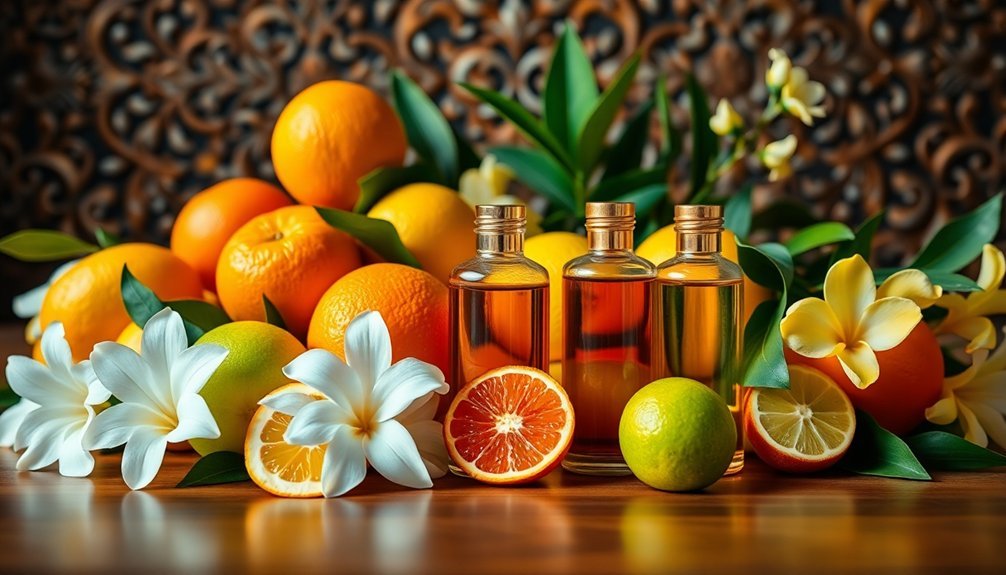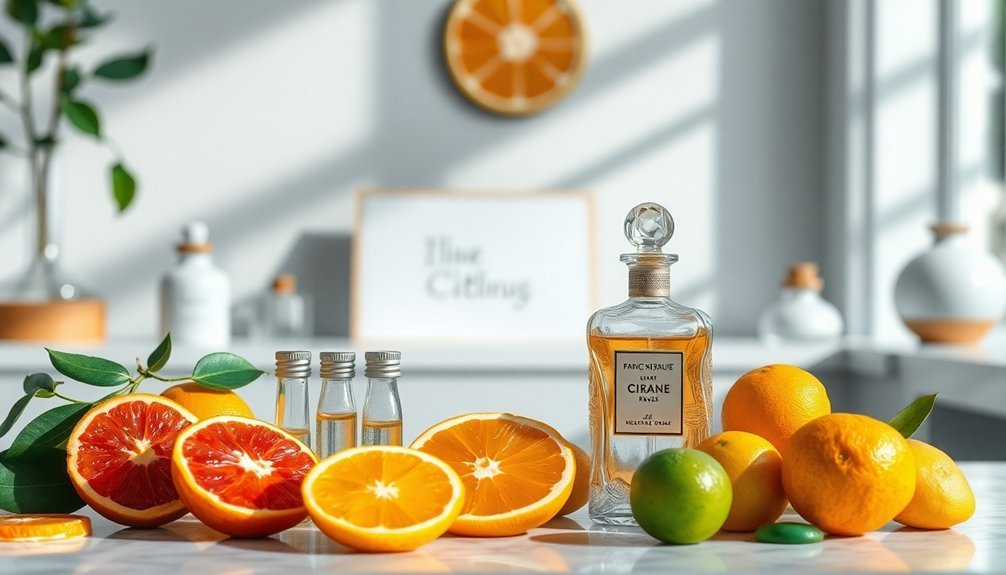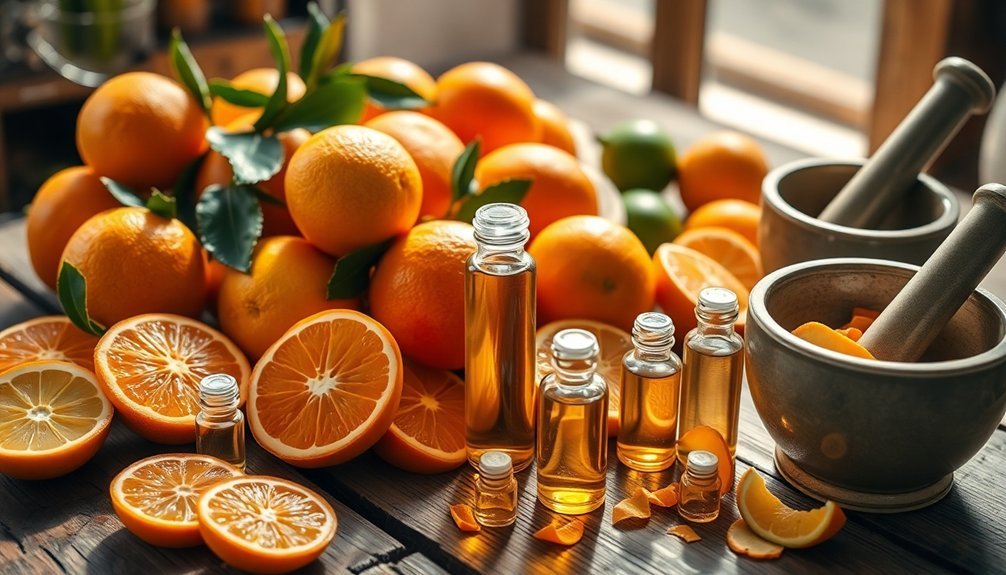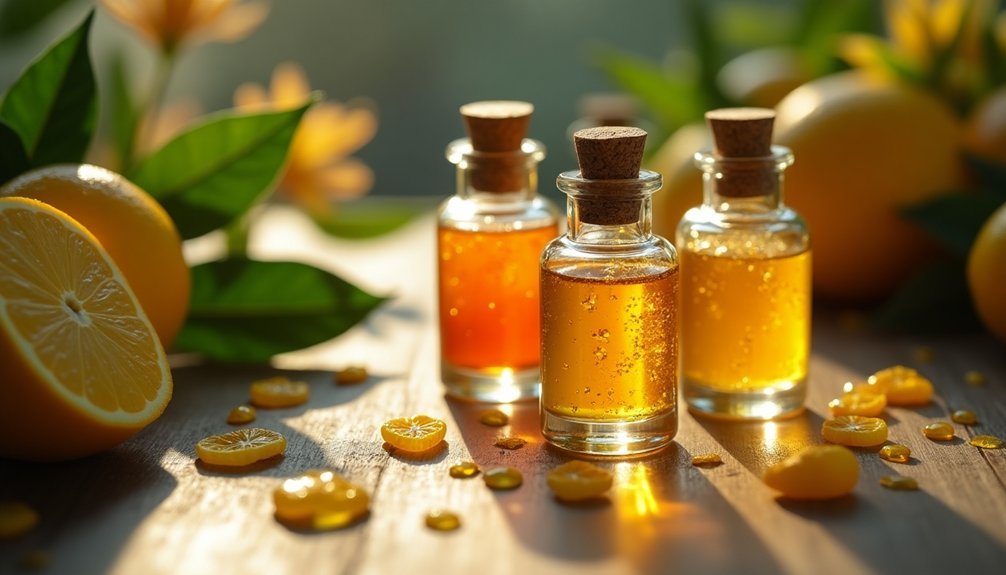To craft an oriental citrus perfume, you'll want to balance bright, zesty top notes like bergamot and mandarin with rich oriental base materials such as amber and patchouli. Start with a 1:1:1 ratio, focusing on complementary fragrances that create harmony between fresh and warm elements. Use steam-distilled oils for longevity, and let your blend mature for at least a week. The secrets of master perfumers reveal techniques that transform good fragrances into extraordinary ones.
The Art of Blending Oriental and Citrus Notes

When creating oriental citrus perfumes, mastering the delicate balance between warm, spicy notes and bright, zesty elements becomes essential to achieving a unique and harmonious blend.
You'll want to start by selecting fragrances that share complementary notes, focusing on oriental spices that pair well with fresh citrus accords. Remember that similar notes work best when experimenting with fragrance combinations.
Begin your blend with small quantities, using a 1:1:1 or 2:1:1 ratio as your starting point. Layer your creation thoughtfully, incorporating citrus or herbs as top notes, spicy elements for the middle, and deep oriental base notes like musk or sandalwood.
Don't rush the process – let your blend rest for at least a week to allow the scents to mature and meld together. Test the mixture on your skin to evaluate how the fragrance develops over time, making adjustments until you've achieved your desired scent profile.
Essential Ingredients for Oriental Citrus Perfumes
When creating oriental citrus perfumes, you'll find that bright top notes like lemon, grapefruit, and bergamot provide an essential fresh lift to the composition.
Your oriental base materials, including patchouli, amber, and precious resins, form the rich foundation that gives these fragrances their distinctive character. Luxury perfumers craft these complex blends to achieve extraordinary sophistication.
To achieve perfect harmony, you'll need to carefully balance sweet elements like vanilla and mandarin against fresher components such as pink pepper and Sichuan pepper.
Top Notes That Shine
The vibrant symphony of top notes in oriental citrus perfumes creates an unforgettable first impression that beckons you into their exotic world.
You'll find bergamot and mandarin leading the charge, expertly blending spicy oriental elements with bright citrus clarity. These top notes work in harmony with aromatic herbs to create a complex opening that's both invigorating and sophisticated. For maximum impact, apply sparingly to allow the notes to develop naturally.
When selecting your oriental citrus fragrance, look for these powerful top note combinations:
- Bergamot paired with artemisia for a fresh, complex start that sets the stage for deeper notes
- Mandarin combined with rosemary, creating a spicy-fresh burst that awakens your senses
- Grapefruit and lavender working together to deliver a zesty yet calming introduction
These combinations guarantee your fragrance opens with impact while maintaining its oriental character.
Precious Oriental Base Materials
Beyond those initial bright citrus notes lies a rich foundation of precious oriental base materials that give these fragrances their distinctive character and lasting power. You'll discover the perfect balance between precious woods like oud and sandalwood, combined with rich resins such as frankincense and myrrh. These ingredients create a sophisticated depth that transforms a simple citrus scent into an exotic oriental masterpiece.
| Base Material | Key Characteristic |
|---|---|
| Oud | Rich, persistent woody notes |
| Frankincense | Warm, oriental-inspired warmth |
| Amber | Sweet, warm stabilizing element |
| Sandalwood | Deep, creamy woody foundation |
| Benzoin | Sweet, vanilla-like richness |
These precious materials not only extend your fragrance's longevity but also add complexity and sophistication that elevates it from a simple citrus scent to a true oriental masterpiece.
Balancing Sweet With Fresh
Creating a harmonious oriental citrus perfume requires mastering the delicate balance between sweet and fresh notes.
You'll find success by combining warm oriental ingredients like vanilla, spices, and amber with bright citrus elements such as mandarin, bergamot, and grapefruit.
To achieve the perfect blend, consider these essential techniques:
- Layer your citrus notes over a rich oriental base, similar to Chanel's Coco Mademoiselle.
- Incorporate aromatic spices like cardamom to enhance the citrus freshness.
- Use green notes as a bridge between sweet and fresh elements.
Remember that while oriental notes provide lasting power, citrus elements are more volatile.
You'll want to apply your fragrance more frequently during spring and summer months to maintain the vibrant balance of sweet warmth and zesty freshness.
Cold-Pressed vs. Steam-Distilled Citrus Notes
You'll notice distinct differences between cold-pressed and steam-distilled citrus notes in your oriental perfumes, particularly in how they project over time.
While cold-pressed oils deliver those bright, zesty bursts that quickly fade, steam-distilled versions offer a more rounded, stable presence that stays longer on your skin.
The extraction method you choose impacts not just longevity but also the overall character of your citrus notes – cold-pressed captures that fresh-off-the-peel vibrancy, while steam distillation yields a softer, more tempered citrus profile.
Extraction Impact On Longevity
The extraction method used for citrus oils plays a decisive role in their longevity and performance in perfumes. While cold-pressed citrus oils deliver vibrant, true-to-fruit aromas, their high terpene content makes them more susceptible to oxidation and faster degradation.
You'll find steam-distilled citrus oils offer better stability, though they might lack the fresh, zesty character of their cold-pressed counterparts.
To maximize the longevity of citrus notes in your oriental perfumes:
- Consider using steam-distilled or folded citrus oils for enhanced stability
- Blend citrus oils with fixatives like frankincense or myrrh to extend their presence
- Layer your citrus notes with complementary middle notes such as lemongrass or lavender to create a more lasting composition
The key is striking the right balance between vibrancy and longevity in your final blend.
Fresh vs. Rounded Notes
When exploring oriental citrus perfumes, understanding the distinction between fresh and rounded notes becomes essential for achieving your desired fragrance profile. Fresh notes, derived from lemons and limes, deliver an immediate burst of energy and typically serve as invigorating top notes. In contrast, rounded notes from sweet oranges and mandarins offer a more balanced, lasting impression.
| Characteristic | Fresh Notes | Rounded Notes | Best Usage |
|---|---|---|---|
| Source | Lemon, Lime, Bergamot | Sweet Orange, Mandarin | Varies |
| Longevity | Short-lived | Longer-lasting | Day/Evening |
| Blend Affinity | Jasmine, Green Tea | Amber, Musk | All seasons |
| Wear Time | Morning, Daytime | Evening, Special Events | Versatile |
You'll find fresh notes perfect for daytime wear, while rounded notes excel in evening compositions, especially when combined with oriental elements like incense and woody bases.
Creating Base Accords for Oriental Citrus Blends

Creating successful oriental citrus blends begins with a carefully constructed base accord that balances warm, sensual elements with bright, citrus notes.
You'll want to start with classic oriental ingredients like vanilla, tonka bean, and labdanum to establish a rich foundation.
To craft your base accord, focus on these essential components:
- Layer amber and woods with vanilla to create the signature oriental warmth that'll support your citrus elements.
- Add resins like benzoin or myrrh to introduce depth and earthiness, enhancing the overall complexity.
- Incorporate musk and patchouli sparingly to achieve the perfect balance of sensuality without overwhelming the citrus notes.
Remember that your base notes need to complement rather than compete with the citrus elements you'll add later, so maintain proportion and balance throughout your composition process.
Balancing Sweet and Fresh Elements
You'll find success in oriental citrus perfumes by carefully pairing sweet vanilla notes with bright citrus elements, maintaining a delicate balance that prevents either component from overpowering the other.
The golden ratio for sweet-fresh blends typically follows a 60:40 proportion, where amber and vanilla form the foundation while citrus adds lift and vibrancy to the composition.
When layering amber with citrus notes, start with a concentrated amber base and gradually introduce citrus elements, allowing each layer to settle before adding the next.
Citrus-Vanilla Harmony Notes
The delicate balance between citrus freshness and vanilla sweetness creates one of perfumery's most enchanting harmonies. When you're blending citrus and vanilla notes, you'll want to focus on creating a seamless connection between the bright top notes and the sweet base elements.
To achieve this perfect harmony, consider these essential steps:
- Start with a blend of lemon and bergamot top notes, which provide an initial burst of freshness.
- Layer in green mandarin and bois de rose as middle notes to create a bridge between citrus and sweet elements.
- Ground your composition with vanilla and tonka bean base notes, adding just enough sweetness without overpowering the citrus.
You'll find that amber and musk can help stabilize this combination, while sandalwood adds depth and longevity to your oriental citrus creation.
Golden Ratio Sweet-Fresh Blends
When crafting oriental citrus perfumes, mastering the golden ratio between sweet and fresh elements becomes essential for achieving a perfectly balanced fragrance.
Begin with the classic 30-50-20 ratio: 30% top notes (fresh citrus), 50% middle notes (sweet meringue or vanilla), and 20% base notes (tonka or musk).
For a 60-drop blend, you'll want to use 18 drops of fresh citrus elements like bergamot, mandarin, or lemon for the top notes.
Follow with 30 drops of sweet middle notes, combining vanilla and meringue accords, then finish with 12 drops of base notes.
You can adjust these proportions to your preference, but always start small and test incrementally.
Let your blend mature for several days, allowing the sweet and fresh elements to harmonize perfectly.
Amber-Citrus Layer Techniques
Mastering amber-citrus layering requires a delicate balance between deep, resinous notes and bright, zesty elements.
You'll find that incorporating herbal accords like tarragon can enhance complexity while preventing the blend from becoming overly sweet. When combining these contrasting elements, consider your skin chemistry, as the final scent will vary based on your personal characteristics.
To achieve the perfect amber-citrus harmony:
- Start with an amber base containing vanilla or benzoin to create a softer foundation.
- Layer complementary citrus notes like bergamot or blood orange on the same skin area.
- Fine-tune the balance by adding herbal elements such as tarragon or basil.
For best results, try experimenting with multi-product layering using shower gels, lotions, and perfumes from the same fragrance family to enhance longevity and create your signature scent.
Seasonal Adaptations in Oriental Citrus Formulations
Successful oriental citrus perfumes adapt dramatically across seasons, requiring thoughtful formulation adjustments to maintain their signature appeal.
You'll find these fragrances perform differently in summer versus winter, with warmer months demanding lighter, more invigorating blends.
In summer, you'll want to reduce the concentration of heavy base notes like amber and vanilla, allowing the bright citrus top notes to shine through without becoming overwhelming in the heat.
For winter wear, you can amplify the warm spices and resins while maintaining the citrus elements, as they'll project longer in cooler temperatures.
Consider layering techniques to customize your oriental citrus fragrance's seasonal performance.
You can enhance summer wear with additional citrus notes or deepen winter versions by incorporating more oriental spices and precious woods.
Modern vs. Classical Oriental Citrus Recipes

The evolution from classical to modern oriental citrus perfumes represents a fascinating journey of innovation while honoring traditional craftsmanship.
You'll find that while classical recipes relied heavily on sandalwood, amber, and sacred resins for ceremonial purposes, today's interpretations blend these traditional elements with contemporary twists.
Modern perfumers have revolutionized oriental citrus fragrances in three key ways:
- Incorporating fresh citrus notes like bergamot and lemon over traditional balsamic bases
- Adding innovative ingredients such as tonka bean and vanilla absolute for nuanced depth
- Focusing on sustainable and artisanal production methods while maintaining complex layering techniques
While classical recipes emphasized spiritual and ceremonial significance, modern blends prioritize versatility and accessibility without sacrificing the rich, multifaceted character that makes oriental citrus perfumes truly distinctive.
Crafting Long-Lasting Oriental Citrus Compositions
Creating long-lasting oriental citrus perfumes demands a deep understanding of both fleeting citrus notes and enduring base ingredients.
You'll need to layer your citrus notes with rich base ingredients like sandalwood, vetiver, and amber to anchor the fragrance. These heavier components act as fixatives, preventing the quick evaporation of citrus molecules.
To enhance longevity, incorporate musks, resins, and tonka bean into your composition. These ingredients provide depth while extending wear time.
You can also boost staying power by using synthetic materials like Iso E Super and Ambroxan. Consider working with higher concentrations, such as Parfum or Eau de Parfum, and combine aromatic oriental notes with spicy woods for complexity.
Remember to balance your composition with floral accords like jasmine or ylang-ylang for an added layer of sophistication.
Signature Blend Techniques for Personal Fragrances

Developing your signature oriental citrus blend requires mastering both fragrance categories and layering techniques.
You'll want to start with universal fragrances as your foundation, then carefully incorporate citrus elements like bergamot or orange with oriental base accents such as incense and woody notes.
- Begin by testing combinations on paper strips, starting with lighter citrus notes and gradually building up to heavier oriental base accents.
- Apply your chosen fragrances in sequence at pulse points, starting with the lightest scent and moving to the most intense.
- Experiment with ratios using multiple strips of each fragrance until you find your perfect balance.
Don't hesitate to mix fragrances within categories or between them.
Consider using complementary body products to enhance and extend your signature blend's longevity throughout the day.
Master Perfumer's Tips for Complex Citrus Orientals
When crafting complex citrus oriental fragrances, master perfumers rely heavily on precise extraction methods and strategic layering techniques.
You'll want to start with cold-pressed citrus oils, particularly bergamot and orange, as they maintain the brightest, most authentic notes.
To create depth, layer your citrus notes over balsamic accords and resins. Start by combining your fresh citrus with spices like cardamom and cinnamon, then build complexity by adding frankincense or myrrh.
Ground these elements with woody bases like sandalwood or cedar.
For a modern twist, you can enhance luminosity by incorporating subtle floral notes or aquatic accords.
Look to classics like Habit Rouge for inspiration – it masterfully demonstrates how to balance bright citrus with rich oriental elements while maintaining sophistication and depth.
Frequently Asked Questions
How Do Skin Chemistry Differences Affect the Longevity of Oriental Citrus Perfumes?
Your skin's natural oils, pH levels, and moisture content directly impact how long fragrances last. Oily skin retains scents longer, while dry skin makes them fade faster. You'll need moisturizer for better longevity.
Can Oriental Citrus Perfumes Trigger Allergies or Skin Sensitivities?
Yes, you're at risk for allergic reactions since citrus oils and oriental fragrance ingredients often contain common allergens like limonene and linalool. If you have sensitive skin, always patch test before applying.
What's the Average Shelf Life of an Oriental Citrus Perfume?
You can expect your oriental citrus perfume to last 3-4 years when stored properly. While the oriental base notes offer stability, the citrus elements may degrade faster, so you'll want to monitor changes carefully.
Are Natural or Synthetic Citrus Notes More Sustainable in Perfume Production?
You'll find natural citrus notes are generally more sustainable due to biodegradable properties and eco-friendly harvesting methods, despite being more expensive. They're less polluting and support biodiversity compared to synthetic production processes.
How Do Altitude and Humidity Affect Oriental Citrus Perfume Performance?
You'll notice your oriental citrus perfumes become stronger at high altitudes due to increased vapor pressure, while humidity extends their longevity. The citrus notes evaporate faster, but oriental base notes last longer in humid conditions.
In Summary
You've now mastered the essentials of blending oriental citrus perfumes. Armed with knowledge of cold-pressed oils, classic base accords, and modern composition techniques, you're ready to create your signature scent. Remember to balance sweet and fresh elements while maintaining the complexity that makes oriental citrus perfumes unique. Don't be afraid to experiment – your perfect blend awaits in the delicate dance between East and West.
References
- https://us.clivechristian.com/blogs/olfactive-family/citrus-fragrance-family
- https://www.perfumestars.com/perfume-notes/citruses/
- https://fraganote.com/blogs/news/fragrance-families
- https://www.youtube.com/watch?v=okVX–qh-pk
- https://www.nicheperfumes.co.za/fragrance-families-oriental
- https://www.birrafragrances.com/blogs/news/the-art-of-mixing-colognes-a-guide-to-creating-unique-scents
- http://pellwall-perfumes.blogspot.com/2012/06/method-for-blending.html
- https://github.com/piotr-yuxuan/autocompletion/blob/master/resources/words.md
- https://www.soapguild.org/tools-and-resources/resource-center/73/beginners-guide-to-fragrance-blending/
- https://armafperfume.com/blogs/blogs/the-science-of-fragrance-blending-creating-perfect-scents





Leave a Reply